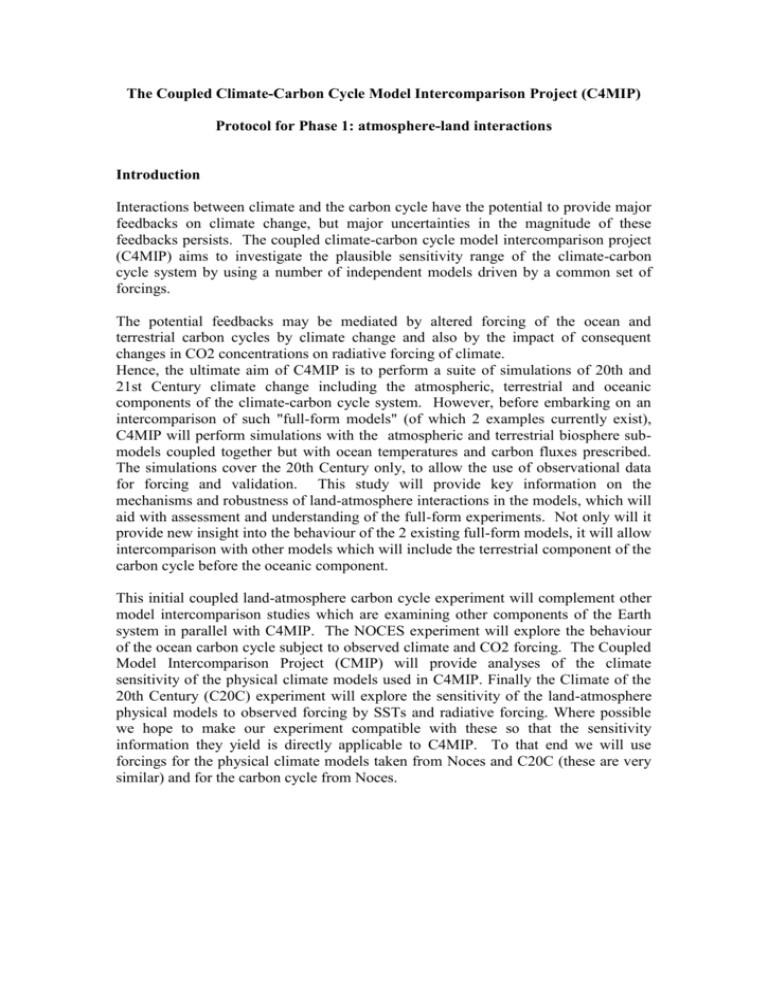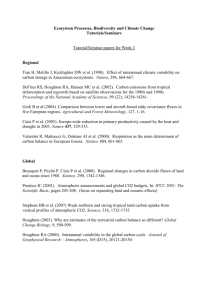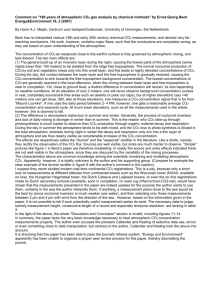The Coupled Climate-Carbon Cycle Model Intercomparison Project
advertisement

The Coupled Climate-Carbon Cycle Model Intercomparison Project (C4MIP) Protocol for Phase 1: atmosphere-land interactions Introduction Interactions between climate and the carbon cycle have the potential to provide major feedbacks on climate change, but major uncertainties in the magnitude of these feedbacks persists. The coupled climate-carbon cycle model intercomparison project (C4MIP) aims to investigate the plausible sensitivity range of the climate-carbon cycle system by using a number of independent models driven by a common set of forcings. The potential feedbacks may be mediated by altered forcing of the ocean and terrestrial carbon cycles by climate change and also by the impact of consequent changes in CO2 concentrations on radiative forcing of climate. Hence, the ultimate aim of C4MIP is to perform a suite of simulations of 20th and 21st Century climate change including the atmospheric, terrestrial and oceanic components of the climate-carbon cycle system. However, before embarking on an intercomparison of such "full-form models" (of which 2 examples currently exist), C4MIP will perform simulations with the atmospheric and terrestrial biosphere submodels coupled together but with ocean temperatures and carbon fluxes prescribed. The simulations cover the 20th Century only, to allow the use of observational data for forcing and validation. This study will provide key information on the mechanisms and robustness of land-atmosphere interactions in the models, which will aid with assessment and understanding of the full-form experiments. Not only will it provide new insight into the behaviour of the 2 existing full-form models, it will allow intercomparison with other models which will include the terrestrial component of the carbon cycle before the oceanic component. This initial coupled land-atmosphere carbon cycle experiment will complement other model intercomparison studies which are examining other components of the Earth system in parallel with C4MIP. The NOCES experiment will explore the behaviour of the ocean carbon cycle subject to observed climate and CO2 forcing. The Coupled Model Intercomparison Project (CMIP) will provide analyses of the climate sensitivity of the physical climate models used in C4MIP. Finally the Climate of the 20th Century (C20C) experiment will explore the sensitivity of the land-atmosphere physical models to observed forcing by SSTs and radiative forcing. Where possible we hope to make our experiment compatible with these so that the sensitivity information they yield is directly applicable to C4MIP. To that end we will use forcings for the physical climate models taken from Noces and C20C (these are very similar) and for the carbon cycle from Noces. Model requirements Participation in C4MIP Phase 1 requires a coupled global model system comprising of: 1. An atmospheric General Circulation Model (GCM) able to transport tracers 2. A terrestrial carbon cycle model able to account for land use changes The models should be as follows: a. The terrestrial biosphere model should take input meteorological data from the atmospheric GCM. b. Land-atmosphere CO2 fluxes should be passed from the terrestrial biosphere model to the atmosphere model. c. The terrestrial biosphere model should update the physical land surface boundary conditions in the atmosphere as a result of: i) the imposed land use changes ii) the responses of dynamic vegetation, if included in the model The coupling should be synchronous (ie: involving time-dependent exchange of information) rather than involving long-term climatological means. Overview of experiment Main simulation The primary objective is to examine the simulation of 20th Century atmospheric CO2 and the CO2 fluxes at the land surface in the coupled atmosphere-terrestrial biosphere models. These quantities will be compared between the models and with observations to examine the consistency of the various observed and simulated changes in the landatmosphere carbon cycle. Each coupled atmosphere-terrestrial biosphere model will simulate the climate and terrestrial carbon budget of the 20th Century, forced by historical observations/reconstructions of atmospheric CO2, sea-surface temperatures (SSTs) and anthropogenic land cover change. In the last few decades of the simulation, the atmosphere submodels will additionally simulate the spatial and temporal structure of atmospheric CO2. This component of the simulation will be forced by the landatmosphere fluxes simulated by the terrestrial biosphere submodels, along with fossil fuel emissions and ocean-atmosphere fluxes prescribed externally. The simulated 3D CO2 field is for diagnostic purposes only, and will not exert any further influences on radiative forcing, plant physiology or surface CO2 fluxes. These processes will continue to depend on the prescribed global-mean CO2 concentration, avoiding the complication of feedbacks. Secondary simulations As well as the main simulation, further simulations may use subsets of the above time-dependent forcings with other forcings left unchanged in time. Is it intended that these decomposed simulations will inform a better understanding of synergisms between the forcings. The groups will also be encouraged to perform 4 further simulations parallel to the final 20 years of the main simulation, with slight perturbations to the initial conditions. The ensemble of 5 simulations will allow the importance of internal variability to be assessed. Sets of perturbated starting conditions will be generated from data archived from the main run, for example through the use of a number of consecutive days of archived data. These secondary simulations are optional for the individual groups, but are highly encouraged. Forcing variables The time-dependent forcing variables for the main simulation are therefore: i) CO2: global annual mean ii) SSTs: monthly mean spatial fields iii) land use: annual mean spatial fields iv) fossil fuel: annual mean, spatial fields v) ocean fluxes: monthly mean spatial fields "Fossil fuel" emissions also include emissions from cement production. The data sources for these forcings are listed in Annex 1. Figure 1 illustrates the application of the forcings to the main simulation. SSTs are applied to the physical atmosphere submodel alone, and land use is applied to the terrestrial biosphere submodel alone. The prescribed global mean atmospheric CO2 is applied to both submodels. In the later stages, fossil fuel and ocean fluxes are applied to the atmospheric CO2 transport submodel alone. Suggested sets of forcings for the decomposed simulations are: a. Time-dependent CO2 and SSTs, but land use fixed at initial state b. Time-dependent land use, but CO2 and SSTs fixed at initial state c. Time-dependent SSTs, but CO2 and land use fixed at initial state The final 20-year ensemble simulations will use the same forcings as the main simulation, but with small perturbations to the initial conditions. Sea-surface temperatures (2-D monthly means) Atmospheric General Circulation Model Atmospheric CO2 (global annual means) Surface climate Land surface properties Atmospheric CO2 (3-D monthly means) Net CO2 fluxes Terrestrial biosphere model Land use (2-D annual means) Fossil fuel CO2 emissions (2-D annual means) Ocean-atmosphere CO2 fluxes (2-D seasonal means) Figure 1. Application of forcings to transient simulations Spinup procedure The simulation will begin at 1900. To provide spin-up conditions with minimal bias introduced by interannual and interdecadal variability, the spin-up will consist of two stages: 1. Equilibrate the model to near pre-industrial conditions, defined as 1850 CO2 and repeated cycles of 1875-1899 SSTs 2. Force the model by 2 cycles of 1875-1899 SSTs, increasing CO2 from 1850 to 1899 Attainment of pre-industrial equilibrium may require several centuries of simulation of the terrestrial biosphere, which will exceed the available computational resources if performed synchronously coupled to the atmosphere. An accelerated spinup with asynchronous coupling is therefore permitted. This may either involve an extended internal timestep for the terrestrial biosphere submodel, or a 3-stage process of offline spinup prior to coupling: 1a. Run the atmosphere submodel for 25 years with 1875-1899 SSTs and 1850 CO2. Save all variables needed to run the terrestrial model 1b. Run the terrestrial biosphere model offline for 1,000 years, with climate variables from step (1a) as input variables repeatedly cycled over the 25 years. 1c. Couple the 2 submodels and run for the 1875-1899 period under 1850 CO2, initialising at the terrestrial state from the 1000-year offline integration. In all stages during spin-up, land use will be fixed at the 1900 state. Transient simulation, 1900-2000 The transient simulation will be forced by historical SSTs, global mean CO2 and land use from 1900-2000. The atmosphere and terrestrial biosphere submodels will interact through the surface meteorology, hydrology and radiation budget. Landatmosphere CO2 fluxes will be simulated by the terrestrial biosphere model, but these will not be used to update the atmospheric CO2 concentration provided as a forcing. The methodology for calculating carbon fluxes following land cover changes will be taken from the Grand Slam CCMLP experiment (see Grand Slam protocol). Simulation of atmospheric CO2 tracer transport as a passive diagnostic will begin at 1959, so fossil fuel emissions and ocean-atmosphere CO2 fluxes will be additional forcings from that time. CO2 updated by fossil fuel emissions, the terrestrial biosphere and ocean fluxes should be transported separately. The atmosphere and terrestrial biosphere submodels will continue to be forced with observed global mean CO2. Ensemble simulations will begin at 1980, so starting conditions will be saved from the main run at this time. Diagnostics The primary validation will consist of comparing the simulated 3-dimensional diagnostic CO2 fields against observations at the stations listed in Annex 2. Other atmospheric and biospheric variables are required for validation against historical climate records and intercomparison with the other models. 3D monthly-mean fields: Temperature Specific humidity Atmospheric CO2 concentration from each tracer (fossil, ocean and land) 2D monthly-mean fields: Outgoing Longwave Radiation (OLR) Presence/fractional cover of plant functional types (PFTs) All terrestrial carbon pools and fluxes - including products and conversion flux from land use - carbon pools and fluxes should be saved per PFT if fractional covers are accounted for LAI (of PFTs if fractional covers are accouted for) Daily mean 2D surface fields: Surface temperature precipitation, upward surface shortwave radiation downward surface shortwave radiation upward surface longwave radiation downward surface longwave radiation wind stress atmospheric pressure soil temperature soil water content + any other field needed to run the terrestrial carbon cycle offline latent heat flux, sensible heat flux, LAI, GPP, NPP, NEP, gs Hourly time series at selected gridpoints: Atmospheric CO2 at station locations listed in Annex 2. Data format Forcing data and diagnostic output from models to be provided in NetCDF format. Formats and, with help from PCMDI, software for producing output in the correct format will be provided at the project host site. Intercomparison workshop The C4MIP Phase 1 workshop will take place in Hamburg on 18th-19th September 2003. All groups are encouraged to attend. ANNEX 1: Forcing data Global mean CO2: Ice core records and flask measurements (Rayner) SSTs: HadISST1.1 Original dataset (monthly means) provided. Groups may need to further process the data prior to input to the GCM to ensure that time interpolation within the GCM does not alter the monthly means. Data processed for use in the Hadley Centre model is available if applicable to other GCMs. Land use: Crops: annual fractional cover at 0.5 degree resolution from SAGE (Ramankutty and Foley) Pasture: locations of pasture as dominant land cover type at 0.5 degree resolution in timeslices at 1900, 1950, 1970 and 1990 from RIVM (Klein Goldewijk). Some processing was necessary for C4MIP (Betts): Pasture was interpolated linearly in time to give annual fractional covers (assuming either 0% or 100% cover in original timeslices). Pasture and/or crop fractions were then modified to ensure that the 2 fractions do not sum to more than 1.0 Ocean carbon fluxes: median fluxes from OCMIP2 Fossil fuel emissions: Andres et al 1996 ANNEX 2: Locations of atmospheric CO2 observations Station name Bass Strait/Cape Grim Bass Strait/Cape Grim Bass Strait/Cape Grim Bass Strait/Cape Grim Bass Strait/Cape Grim Bass Strait/Cape Grim Bass Strait/Cape Grim Alert, Greenland Amsterdam Island Ascension Island Assekrem, Algeria St. Croix, Virgin Is. Azores Baltic Sea, Poland Baring Head St., NZ Bermuda West Barrow, Alaska Black Sea, Romania Carr, CO Carr, CO Lat -40.38 -40.38 -40.38 -40.38 -40.38 -40.38 -40.38 82.45 -37.95 -7.92 23.18 17.75 38.75 55.50 -41.41 32.27 71.32 44.17 40.90 40.90 Long Elev. Wind 144.39 500 SW NS 144.39 1500 SW NS 144.39 2500 SW NS 144.39 3500 SW NS 144.39 4500 SW NS 144.39 5500 SW NS 144.39 6500 SW NS -62.52 210 SW 77.53 150 -14.42 54 5.42 2728 NS -64.75 3 -27.08 30 16.67 7 174.87 80 S,SW -64.88 30 -156.60 11 E,NE 28.68 3 NE -104.80 3000 NS -104.80 4000 NS Topo Carr, CO Carr, CO Cold Bay, Alaska Cape Ferguson, Aust. Cape Grim, Tasmania Christmas Island Mt. Cimone St., Italy Cape Meares, OR Cape Rama, India Crozet, Indian Ocean Cape St. James, Canada Darwin, Australia Easter Island Estevan Pt, BC, Canada Guam Dwejra Pt., Malta Halley Bay, Antarctica Hungary Storhofdi, Iceland North Carolina North Carolina Canary Islands Jubany St., Antarctica Key Biscayne, FL Kosan, Rep. of Korea Kumukahi, Hawaii Wisconsin tower Wisconsin tower Lampedusa, Italy Mawson St., Antarctica Mould Bay, Canada Sand Island, Midway Mauna Loa, Hawaii Minamitorishima, Japan Macquarie Island Olympic Peninsula, WA Plateau Rosa St., Italy Palmer St., Antarctica Qinghai Province, PRC Ragged Pt., Barbados Ryori St., Japan Schauinsland, Germany South China Sea South China Sea South China Sea South China Sea South China Sea South China Sea South China Sea Sable Island, NS, Canada 40.90 -104.80 5000 NS 40.90 -104.80 6000 NS 55.20 -162.72 25 -19.28 147.06 2 E -40.68 144.68 94 SW 1.70 -157.17 3 44.18 10.70 2165 NS 45.48 -123.97 30 W,NW 15.08 73.83 60 S,SE -46.45 51.85 120 51.93 -131.02 89 W -12.42 130.57 3 W,NW -29.15 -109.43 50 49.38 -126.55 39 W 13.43 144.78 2 36.05 14.18 30 -75.67 -25.50 10 46.95 16.65 300 63.25 -20.15 100 35.35 -77.38 60 35.35 -77.38 500 NS 28.30 -16.48 2360 NS -62.23 -58.82 15 25.67 -80.20 3 S 33.28 126.15 72 19.52 -154.82 3 45.93 -90.27 500 NS 45.93 -90.27 850 NS 35.52 12.62 85 -67.62 62.87 32 76.25 -119.35 58 28.22 -177.37 4 19.53 -155.58 3397 NS 24.30 153.97 8 -54.48 158.97 12 48.25 -124.42 488 W 45.93 7.70 3480 NS -64.92 -64.00 10 36.27 100.92 3810 NS 13.17 -59.43 3 39.03 141.83 230 E 48.00 8.00 1205 NS 3.00 105.00 15 6.00 107.00 15 9.00 109.00 15 12.00 111.00 15 15.00 113.00 15 18.00 115.00 15 21.00 117.00 15 43.93 -60.02 5 E Mahe Island, Seychelles Shemya Island, Alaska Shetland Is., Scotland Samoa South Pole Atlantic Ocean, Norway Pacific Ocean, Canada Syowa, St., Antarctica Tae-ahn Pen., Korea Wendover, Utah Ulaan Uul, Mongolia Westerland, North Sea Sede Boker, Israel Zeppelin St., Norway Adrigole, Ireland Fraserdale, Ont, Canada Kitt Peak, AZ Lauder, NZ Neumayer, Antarctica Scripps Pier, CA Table Mtn., CA Trinidad Head, CA -4.67 52.72 60.17 -14.25 -89.98 66.00 50.00 -69.00 36.73 39.90 44.45 55.00 31.13 78.90 52.00 49.88 31.90 -45.00 -71.60 32.83 34.40 41.05 55.17 174.10 -1.17 -170.57 -24.80 2.00 -145.00 39.58 126.13 -113.72 111.10 8.00 34.88 11.88 -10.00 -81.57 -111.60 169.70 -8.30 -117.27 -117.70 -124.15 3 40 30 42 2830 7 7 11 20 1320 914 8 W 400 NW 474 50 SW 210 2090 NS 370 S 16 14 W 2258 NS 109 W Columns are 1 Name 2 Latitude 3 Longitude 4 Elevation (meters), 5 Wind : model sampling should be moved to the next gridcell according to the given wind direction. 6 Topo: Topography of the site: NS means nonsurface so that we don't believe the model has a hope of matching the topography and you should pretend it's free atmosphere.







